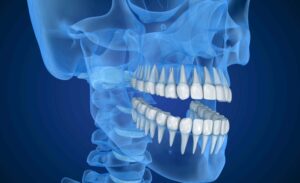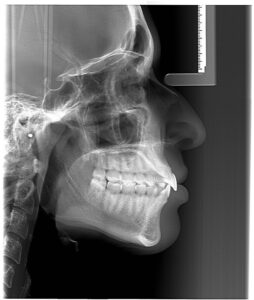
According to an article in Forbes Health,
“ …dental implants have grown in popularity since the 1970s as an alternative to dentures or bridges to replace unhealthy or missing teeth. Although only 6% of Americans have implants now, by 2026 that number is set to grow to 23%.”
The rising popularity of dental implants is credited to a number of reasons, including protecting the health and well-being of surrounding teeth by halting the process of bone loss.
When teeth are lost, so are their roots. Tooth roots are what provide stimulation and nourishment through their connections to the jaw bones that support them. When the teeth are no longer present, the bone begins to shrink, or “resorb.”
Resorption begins slowly the first year but the pace increases with each passing year. For individuals who wear partials or dentures to replace missing teeth, resorption is accelerated by the pressure applied by these appliances.
Over time, the decline in jaw bone mass becomes obvious through changes in facial appearance. Bone loss contributes to deep wrinkles around the mouth, causing the corners of the mouth to turn downward even in a smile.
For those who wear dentures or partials, the fit comes less dependable due to the declining height of the “arch” the appliance is positioned on. This is when people often complain that their appliance is rubbing sore spots on the gums or moving when chewing certain foods.
Another advantage of dental implants is their longevity. When properly maintained, a dental implant can last a lifetime. Dental implants don’t break, get cavities, or require root canals. They are a “one and done” solution for missing teeth!
However, many individuals still feel that dental implants are out of reach. In a number of cases, they have misconceptions that have prevented them from going forward with what is often a life-changing decision. A few of these are:
• “I was told dental implants cost $xxxx each and I have six missing teeth. I did the math and can’t afford that.”
This is always frustrating to hear, as it deters many people from learning the true cost of their options in implant treatment. While treatment costs are largely based on the number of dental implants placed, one implant is often able to support two or three teeth. For those who are missing all upper or lower teeth, six to eight implants can dependably support a full arch of teeth. With over 40 different types of implant systems, the ones best suited for you may provide a less expensive option than you’ve assumed in the past. We also offer flexible payment plans that break the fee into easy monthly amounts. Most plans require no down payment and are interest free.
• “I was told I didn’t have enough bone to support a dental implant.”
Indeed, there needs to be sufficient bone depth for implant placement. For individuals who have lost a great deal of bone, specific implant types may be recommended. Some, like the “All On 4“ implant system, use specially designed implants that are placed at certain angles. Bone loss can also be overcome by incorporating a bone rebuilding process into treatment. This is done prior to implant placement and does not require a bone graft. In many cases, we can apply a bone rebuilding material that restores ample bone mass.
• “I heard treatment can take 6 months or more. I don’t want to be without teeth that long.”
No one wants to spend months or even weeks without teeth in place. And, while in dental implant treatment, you’ll be able to wear a dental appliance, temporary crown or bridge without worry. The look will be comfortable and you’ll be able to eat most foods comfortably.
• “I’ve always had painful experiences at a dentist and I can’t imagine having a dental surgery.”
Although dental implant placement can technically be termed a “surgery,” it’s less invasive than this sounds. In placement, a small incision is made in the gums at the placement site. Then, a small hole is made in the jaw bone for the implanted portion. Once placed, the gum tissue is moved to recover the implant. For the next several months, the bone will grow around the implant to secure it in place. There is no sensation of its presence during this time. Throughout the procedure, patient comfort is a high priority. Thorough numbing is applied in addition to Oral Sedation. For those who prefer, I.V. Sedation (“twilight sleep”) can be used.
Our Macomb County dental office is specifically structured for all phases of implant dentistry, from placement to the restoration of your smile. Our dental office also features a unique array of advanced technology. One that is especially helpful in determining the type and placement of dental implants is Cone Beam 3D Imaging.
Cone Beam images capture clear, concise 3D views in one pass at the lowest radiation levels possible. These images are ideal for assessing jaw structure for proper angles and depths in implant placement.
If you’re ready to replace missing teeth with a lifetime of confident smiles, call 586-739-2155 or tap HERE for a free consultation appointment. During this time, I’ll answer your questions and discuss potential options that may be best for you.
Learn more about comfort at: DrBarbatComfort
Get to know us and our commitment to your dental implant treatment success by viewing a brief video at: DrBarbatDentalImplants
You can also tour our dental office at: DrBarbatOfficeTour